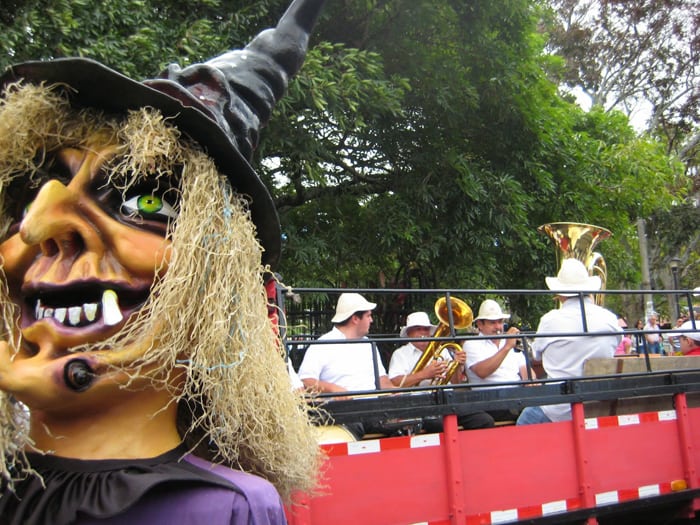This is a bewitching time of the year. Halloween. Guy Fawkes Day. The Day of the Dead. The change of seasons. And for us Scorpios, another year added on. But the folks in the western San José suburb of Escazú always have witches to worry about. Known as the city of witches, its emblem is a pointyhatted, crooked-nosed silhouette speeding off on a broom, a figure found on business establishments, printed material and bumper stickers. How did this city, now an upscale metropolitan area, acquire such a rare reputation?
From the witches, of course. Escazú was “discovered” in 1561 by Juan de Cavallón, though needless to say it had been there long before de Cavallón came along. The name Escazú comes from the word itskatzu, presumably an indigenous Huetar word meaning “a rock to rest on.” This was once a way station on the trail between Aserrí, south of San José, and Pacaca, near Ciudad Colón, southwest of the capital.
By the 1600s, the area was fairly well populated with descendants of the early Spaniards. Early records mention a José de Alvarado of Hacienda Santa Ana who transferred property to Petronila de Retes (a daughter or niece?) as a dowry.
Even back then, the area was known for its witches, brujas or curanderos, however you want to call them. They were for the most part single women, widows or abandoned wives, who relied on selling “cures” to earn a living. They were the nurses and midwives of this early era, and they were usually knowledgeable in natural medicines using herbs, roots, even animal parts – sort of like the chicken soup and green tea of today.
Although curanderos existed in populated areas all over the country, Escazú became especially noted for its cures, and people came from far away to visit its witches. Folks believed they had special powers or magic to effect cures and offer protection from hexes and the dreaded evil eye. Curanderos could also restore wandering husbands, find lovers for the lonely, cure infertility, find stolen goods, make the insane sane and the cows and chickens more productive. They could also put a hex on someone.
In far-off Spain, the Inquisition was burning witches at the stake, and though the colonists disapproved of such extreme measures, the early 1800s spawned anti-witch sentiment, and the word bruja replaced curandero. By then, too, the medical profession became established and looked down on the competition.
In 1821, the year of independence, the local government passed a law to prohibit the practice of curanderos who “defraud and cheat the public.`” However, public reaction was so strong that the law was revised to say that they could practice so long as they didn’t use crosses or religious symbols.
In 1840, Escazú placed a restraining order against Josefa B. “for being a woman of bad conduct, prostitution and practicing hexes and other bad beliefs.”
Around 1900, Norlico Ratón, “an old man with small eyes who sneezed all the time” was a well-known witch who was sought out for his cures. He recommended powders to sprinkle in the path or slip into the coffee of someone you want to change.
Another known witch, Ña Matea, was an expert on both the removal and the implementation of the evil eye. Her potions included crushed cockroaches and scorpions, and she was known for curing “female trouble.”
Do witches still exist here? Indeed, they do. Right on Avenida Central in San José you can visit the Church of Strong Prayer to the Holy Spirit (Iglesia de la Oración Fuerte al Espíritu Santo), which offers cures for bad luck, nervousness, hallucinations, hearing voices, unemployment, nightmares and envy.
Its literature promises that a “sacred rose” placed in the house for seven consecutive days will absorb all the badness within the home and family, and that a dab of holy oil will get rid of your demons. This is just one of many practitioners that promise cures.
Now, as then, faith can move mountains.






